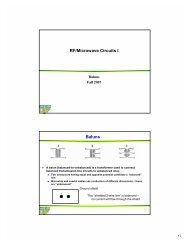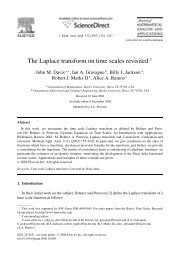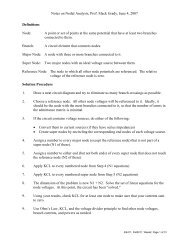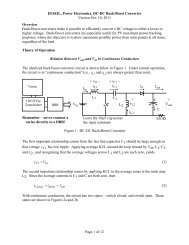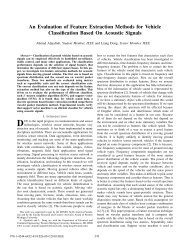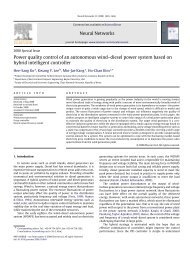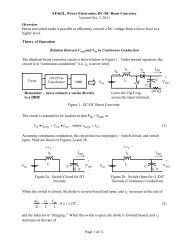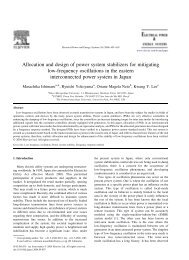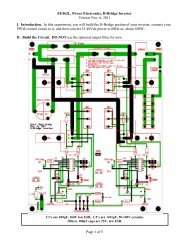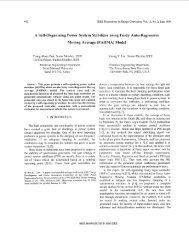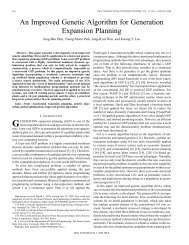Isometric Shoulder Girdle Strength of Healthy Young Adults - ECS
Isometric Shoulder Girdle Strength of Healthy Young Adults - ECS
Isometric Shoulder Girdle Strength of Healthy Young Adults - ECS
You also want an ePaper? Increase the reach of your titles
YUMPU automatically turns print PDFs into web optimized ePapers that Google loves.
<strong>Isometric</strong> <strong>Shoulder</strong> <strong>Girdle</strong> <strong>Strength</strong> <strong>of</strong><strong>Healthy</strong> <strong>Young</strong> <strong>Adults</strong>Brian A. Garner, PhD, Department <strong>of</strong> Mechanical EngineeringJoe Shim, PhD, Department <strong>of</strong> Health, Human Performance, and RecreationBaylor University, Waco, Texas, 76798, USACorresponding Author:Brian A. Garner, PhDOne Bear Place #97356Waco, TX 76798-7356, USATelephone: (254) 710-4191Fax: (254) 710-3839Email: brian_garner@baylor.eduClinical BiomechanicsWord count: 4061
AbstractBackground: <strong>Shoulder</strong> girdle muscles are important for stabilizing the scapula and orienting theglenoid for upper extremity motion. However, data describing shoulder girdle strength and how it varieswith position is lacking.Methods: A series <strong>of</strong> experiments was conducted to measure isometric strength at three positionseach for elevation, depression, protraction, and retraction <strong>of</strong> the shoulder girdle. Nineteen healthy menand women (ages 19 to 23 years) participated in the study. Subjects were seated in a custom apparatusand asked to push or pull with extended arms as forcefully as possible against force-sensing handles.<strong>Shoulder</strong> girdle elevation angle and protraction angle were recorded with a video system during the tests.Findings: In each direction the force generated by the shoulder girdle varied significantly(P0.83).Interpretation: Functional tasks such as bench press may be good indicators <strong>of</strong> shoulder girdlestrength in some directions.Keywords: shrug, elevation, depression, protraction, retraction, scapula, clavicleWord count: 246-2-
IntroductionKnowledge <strong>of</strong> the strength characteristics at a joint can be valuable for a variety <strong>of</strong> applications.<strong>Strength</strong> measured from an impaired individual can be compared against healthy strength characteristicsto indicate the nature, locality, and severity <strong>of</strong> musculoskeletal injury (Mayer et al., 2001). <strong>Strength</strong> datamay be used in engineering applications to design safe and effective products or devices (Peebles &Norris, 2003; Garner 2007). Finally, strength measurements may be used in research to investigate jointforce variability in motor control (Christou et al., 2002), or to validate computer models representingmusculoskeletal biomechanics (Garner & Pandy, 2001; Garner & Pandy, 2003; Holzbaur et al., 2005).Joint strength is commonly characterized by measuring the external moment or force generatedby the contributing muscles during maximal, voluntary effort (e.g., Winters & Kleweno, 1993). Thesemeasures typically vary with joint position and velocity, and reflect the complex interactions betweenjoint geometry and muscle physiology. The geometric relationship between the muscle path and jointaxis dictates the muscle’s excursion (i.e., length variation over the range <strong>of</strong> joint motion) and itsmechanical advantage at the joint (i.e., moment arm). In turn, the muscle excursion determines musclefiber lengths and shortening velocities, which, along with physiological cross-sectional area andneuromuscular adaptations, dictate the capacity <strong>of</strong> a muscle to produce force (Zajac, 1989; Wilmore &Costill, 2004).Although many studies have reported strength measurements at joints in the lower extremity,upper extremity, and back (e.g., Knapik et al., 1983; Graves et al., 1990), studies quantifying the strength<strong>of</strong> the shoulder girdle are lacking, despite the importance <strong>of</strong> this joint in upper-extremity motion.Muscles actuating the shoulder girdle are responsible for stabilizing the scapula and coordinating withglenohumeral movements to effect the wide-ranging, phased kinematics <strong>of</strong> the shoulder joint (Poppen &Walker, 1976). Proper strength ratios between the agonist and antagonist muscles <strong>of</strong> the shoulder girdleare believed important for proper alignment <strong>of</strong> glenoid forces and for reducing susceptibility toglenohumeral instability and overload rotator cuff injury (Kibler, 1998; Mayer et al., 2001; Wilk et al.,2002).In the past, shoulder girdle strength has been assessed using basic exercises whose grossmovements involve the shoulder girdle muscles (Rutherford & Corbin, 1994; Kibler, 1998). Examplesinclude push-ups, pull-ups, scapular pinches, and seated lat pulls. While strength exhibited duringfunctional tasks is important, it may not reflect the maximal capacity <strong>of</strong> muscles activating specific jointsdue to its dependence on motor coordination and the strength <strong>of</strong> other involved joints.A few recent studies have sought to measure shoulder girdle strength more directly. Cools et al.(2002) measured isokinetic protraction and retraction strength <strong>of</strong> the shoulder girdle in the scapular plane.The study reported unilateral peak force and total work, but did not consider the role <strong>of</strong> joint position.-3-
Wilk et al. (1999, 2002) reported the isometric strength <strong>of</strong> male pr<strong>of</strong>essional baseball players for fourdirections <strong>of</strong> shoulder girdle movement. However, strength was reported at only one, unspecifiedposition in each direction, and the measurement methods were not fully described. To our knowledge, noprevious study has reported isometric shoulder girdle strength for male and female subjects as a function<strong>of</strong> position.The purpose <strong>of</strong> this study was to 1) measure maximum isometric force generated by the shouldergirdle during elevation, depression, protraction, and retraction exercises, 2) assess how these forces varywith joint position in each direction, and 3) evaluate possible correlations between these strengthmeasures and other subject-specific characteristics such as gender, bodyweight, and bench-press strength.MethodsA series <strong>of</strong> experiments was performed to measure isometric force generated by the shouldergirdle at three positions each for four directions <strong>of</strong> shoulder girdle movement. The experiments wereapproved by the Baylor University Institutional Review Board, and all subjects signed informed consent.For purposes <strong>of</strong> this study, the four directions <strong>of</strong> shoulder girdle movement were defined as follows:elevation is pulling upwards, and depression is pushing downwards with the arms alongside the uprighttorso; protraction is pushing forwards, and retraction is pulling backwards with the arms positionedhorizontally anterior to the upright torso.SubjectsNine female and ten male volunteers were recruited to participate in the study. All subjects werehealthy, involved in regular physical activity, and had no recent (~5 years) history <strong>of</strong> joint disorder orinjury to the arms, shoulders, neck, or back. Subject ages ranged from 19 to 23 years. The average heightand mass <strong>of</strong> the female subjects was 164.0 (SD=11.3) cm and 64.4 (SD=9.7) kg, respectively. That <strong>of</strong> themale subjects was 176.5 (SD=8.5) cm and 82.4 (SD=20.1) kg, respectively.ApparatusA custom apparatus was constructed to facilitate the experiments (Figure 1). The apparatusconsists <strong>of</strong> a stable base supporting an upright seat that is adjustable to accommodate users <strong>of</strong> differentheights. Affixed to the top <strong>of</strong> the seat’s vertical post is a horizontal member that extends laterally oneither side and then forward. To this member is hinged a set <strong>of</strong> sturdy arm beams that rotate about an axisaligned approximately with the shoulder flexion and extension axis <strong>of</strong> a seated subject. The arm beamscan be pinned at one <strong>of</strong> a number <strong>of</strong> angles ranging from vertically downward, to horizontally forward, tovertically upward. A grip assembly clamps onto and spans between the distal ends <strong>of</strong> the two arm beams.-4-
The grip assembly contains two handles mounted via force-sensing load cells, and may be pinned at one<strong>of</strong> numerous positions along the proximal-distal length <strong>of</strong> the arm beams.<strong>Strength</strong> measurements were conducted with a subject seated in the apparatus and grasping thegrip handles with elbows fully extended. For elevation and depression trials the arm beams were pinnedin the vertically downward position. For protraction and retraction trials the arm beams were pinned inthe horizontally forward position. For each experimental trial the grip assembly was adjusted proximallyor distally to a position which accommodated the user’s arm length while maintaining the shoulder girdleposition prescribed for the trial. For both elevation and depression trials forces were measured with theshoulder girdle in a depressed, neutral, and elevated position. For protraction and retraction trials forceswere measured with the shoulder girdle in a retracted, neutral, and protracted position. Neutral positionswere selected somewhat central to the other two positions in each direction, and near the natural,anatomical position. The actual position <strong>of</strong> the shoulder girdle during each trial was recorded by video asdescribed below. Straps around the chest and lap were used to secure the subject in place withoutinterfering with their strength performance.Force and motion data were collected during the experimental trials. The load cells recordedforces applied to each handle as generated by the shoulder girdle and transmitted through theglenohumeral joint and extended arm. The SSM series load cells (Transducer Techniques, Temecula,CA, USA) were each rated to measure up to 2.2 kN (500 lb) <strong>of</strong> force in both tension and compression. Athree-camera, video motion capture system (zFlo Motion, Inc., Quincy, MA, USA) recorded the threedimensionalpositions <strong>of</strong> reflective markers adhesively attached to the subject’s skin at the jugular notch(JN), acromioclavicular joint (AC), and seventh cervical vertebra (C7). The video and force data werecollected at 60 Hz and 300 Hz, respectively.Experimental ProtocolEach subject was asked to complete one familiarity session and three data collection sessions onseparate, non-consecutive days. During the familiarity session the subjects practiced strength trials ineach direction beginning with submaximal effort and building to maximal effort. Subjects were measuredfor anthropometry and for one-repetition maximum (1RM) bench press according to the standardassessment protocol <strong>of</strong> the National <strong>Strength</strong> and Conditioning Association (Baechle & Earle, 2000).Each subject’s range <strong>of</strong> voluntary shoulder girdle motion in the elevation-depression direction and in theprotraction-retraction direction was recorded using the motion capture system. Within this range threeappropriate testing positions for each <strong>of</strong> the four directions <strong>of</strong> shoulder girdle motion were selected.Positions were selected for each subject so as to span a major portion <strong>of</strong> the range <strong>of</strong> motion in eachdirection, and to permit the subject to generate substantial force at each position. The respective positions-5-
selected for elevation and protraction were not necessarily the same as for depression and retraction,respectively.During each <strong>of</strong> the three data collection sessions the subjects were asked to complete a total <strong>of</strong>twelve strength trials: three trials at different positions for each <strong>of</strong> the four testing directions. For eachtrial, subjects were instructed and observed to maintain extended elbows while exerting maximum forceagainst the grip handles. Extended elbows configure the arm as a rigid link to prevent possible elbowweakness from confounding maximal shoulder girdle effort. The grip assembly pin locations werenumbered so that the positions selected for each subject and each trial could be repeated over the threedata collection sessions. Prior to the testing trials subjects were asked to warm up for several minutes ona hand-powered cycle ergometer with light resistance. Between trials subjects were given one to twominutes <strong>of</strong> rest while the apparatus was adjusted in preparation for the next trial. The order <strong>of</strong> the trialswas varied over the three testing sessions to reduce the risk <strong>of</strong> bias.Data AnalysisFive seconds <strong>of</strong> data were collected for each trial. Plots <strong>of</strong> measured positions and forces overthis period were analyzed visually to identify a single time instant, following stabilization <strong>of</strong> shouldergirdle position, where maximum total force was generated. There was little difficulty identifying anappropriate time instant for each trial as the positions and forces settled to fairly constant values in mostall cases. For the selected time instant, the elevation angle, protraction angle, and total force (sum <strong>of</strong> leftand right sides) were recorded to represent the subject’s performance for the trial. To nullify gravitationalcontributions, the magnitudes <strong>of</strong> elevation and depression forces were increased and decreased,respectively, by each subject’s arm weight (both arms), assumed to be 11.2% <strong>of</strong> bodyweight based ondata reported by Winter (1990) as derived from Dempster (1955).The shoulder girdle elevation angle and protraction angle were computed for each trial based onthe recorded positions <strong>of</strong> the anatomical markers JN, C7, and AC. The midpoint (MP) between JN andC7 was used as a reference to compute these angles as defined for this study. Elevation angle was definedas the angle <strong>of</strong> line MP-AC above the horizontal plane, and protraction angle was defined as the angle <strong>of</strong>line MP-AC anterior to the frontal plane (see Garner et al., in review, for more details).A repeatability analysis was performed on the data collected over the three data-collectionsessions as detailed in Garner et al. (in review). In short, the analysis showed Shrout and Fleiss (1977)interclass correlation coefficients ICC(2,1) <strong>of</strong> 0.79 to 0.95 (good to excellent) for force measurements, <strong>of</strong>0.85 to 0.89 (very good) for elevation angle measurements during elevation and depression tests, and <strong>of</strong>0.68 to 0.88 (good to very good) for protraction angle measurements during protraction and retractiontests.-6-
To summarize recorded strength characteristics for the purposes <strong>of</strong> this study, the elevation angle,protraction angle, and shoulder girdle force recorded over the three days <strong>of</strong> testing were averaged for eachsubject and each strength test. The averages and standard deviations <strong>of</strong> these data were then computed forthree groups: all female subjects, all male subjects, and all subjects combined. Simple t-tests wereperformed to compare male strength with female strength, and to compare agonist strength withantagonist strength. One-way ANOVA with repeated measures on shoulder girdle position, and two-bythreeANOVA (gender x position), was performed for shoulder girdle force. A P-value <strong>of</strong> less than 0.05was used to determine significance.ResultsThe observed average range <strong>of</strong> motion for all subjects was 32.5 degrees for elevation angle and39.5 degrees for protraction angle (Table 1, Figure 2 range-<strong>of</strong>-motion lines). Elevation angle ranged onaverage from positions where the MP-AC line was just below horizontal by 4.6 degrees to a substantialangle <strong>of</strong> 27.9 degrees above horizontal. Average protraction angle was fairly symmetric about the frontalplane, ranging from 18.2 degrees posterior to the plane to 21.3 degrees anterior to the plane. Comparison<strong>of</strong> the sum <strong>of</strong> minimum and maximum elevation angles between female and male subjects indicated thatthe female range <strong>of</strong> motion (-2.4 to 29.5 degrees) was significantly more elevated than the male range <strong>of</strong>motion (-7.0 to 26.1 degrees). Comparison <strong>of</strong> the sum <strong>of</strong> minimum and maximum protraction anglesindicated no significant differences between genders.The measured forces in all directions were substantial, and in each direction varied significantlyand monotonically with position, F(2,36)>25.5, p
the three measured positions were greater than those <strong>of</strong> females by 57% for elevation, 38% fordepression, 81% for protraction, and 78% for retraction (compare males and females in Figure 2).The relative magnitudes <strong>of</strong> agonist and antagonist forces differed significantly over the measuredrange <strong>of</strong> motion for all subjects and for each gender group. Elevation forces averaged over the range <strong>of</strong>motion for all subjects were 70% greater than the average depression forces. For females this percentagewas lower at 57%, and for males it was higher at 79%. For both gender groups the protraction forcesaveraged over the range <strong>of</strong> motion were about 37% greater than the average retraction forces.Cross-correlation analysis on subject height, bodyweight, 1RM bench press, and the strengthmeasurements in each <strong>of</strong> the four testing directions indicated strong and significant correlations betweenthese variables (Table 2). The weakest and only non-significant (P=0.14) correlation was found betweenbodyweight and depression force (r=0.35). The strongest significant (P
positions somewhat narrower than the full range <strong>of</strong> motion in each direction. Based on our anecdotalexperiences at the extreme positions, and the consistent monotonic strength patterns observed for alldirections tested, we believe it is reasonable to assume that shoulder girdle strength drops <strong>of</strong>f steeplytoward the agonist limits <strong>of</strong> the ranges <strong>of</strong> motion in each direction (e.g., elevation strength falls <strong>of</strong>f atmaximum elevation angle).Near the antagonist range-<strong>of</strong>-motion limits (opposite the directions <strong>of</strong> applied force) in eachdirection it was likewise difficult to measure strength due to unavoidable laxity in the testing apparatusand strapping. It was at these positions that subjects seemed to be strongest, and as subjects began toapply force their shoulder girdle positions tended to move slightly in the agonist directions and away fromthe antagonist limits. Tests in some directions proved more difficult than others. For elevation andprotraction tests the subjects pressed themselves into the seat and seat back, respectively, and so laxitywas minimal in these directions, and strength measurements could be made fairly near the antagonistlimits. It was most difficult to secure the subject against the seat during depression tests. Although apadded board was strapped tightly around the subject’s lap to hold them down, as they depressed againstthe handles appreciable depression movement was observed in the shoulder girdle. As a result, all themeasurements <strong>of</strong> depression force tended to be at more depressed positions relative to the range <strong>of</strong> motion(Figure 2, depression).The reported results involving depression strength may be somewhat distorted due to the moredepressed positions at which depression strength was measured. For example, the 170% ratio <strong>of</strong>elevation-to-depression strength may be exaggerated because depression force magnitudes declinedsubstantially at the most depressed position. More realistic comparisons could perhaps be obtained byconsidering the depression force averaged over only the two more elevated positions at which depressionstrength was measured. In such a case, the elevation-to-depression strength ratio becomes 156% (145%for females, 162% for males), which is closer to, but still higher than, the protraction-to-retractionstrength ratios (~137%). In addition, correlations with depression strength (Table 2) increase somewhat(
strength over female strength observed for force in this study would be even greater if reported as jointmoments.The 1RM bench press was found to correlate significantly with shoulder girdle strength in all fourdirections tested, but most closely with elevation and protraction strength (Table 2). Figure 3 showselevation and protraction forces measured at neutral positions plotted against 1RM bench press strengthfor all subjects. The strong correlations observed between these variables lend credence to the historicalpractice <strong>of</strong> using functional tasks as indicators <strong>of</strong> shoulder girdle strength, despite the dependence <strong>of</strong> thesetasks on motor coordination and the strength <strong>of</strong> other participating joints. It seems natural that benchpress and protraction strength would show strong correlation (r=0.84) because they share a commondirection <strong>of</strong> force. The strong correlation (r=0.83) between bench press and elevation strength seems lessintuitive because <strong>of</strong> the orthogonal directions <strong>of</strong> force, but may coincidentally reflect a commoncharacteristic <strong>of</strong> overall shoulder girdle strength (elevation and protraction strength correlated withr=0.92). However, the weaker correlation (r=0.58) between bench press and depression strength serves asa caution against using functional task performance universally as an indicator for all directions <strong>of</strong>shoulder girdle strength.Although this study is unique, it seems appropriate to draw comparisons between our results andthose <strong>of</strong> the two known previous studies that have directly measured shoulder girdle strength. Cools et al.(2002) measured unilateral, isokinetic protraction and retraction strength for a pool <strong>of</strong> healthy subjects (10females, 9 males) very similar to our subject pool (9 females, 10 males). Their averaged peak forcessummed over dominant and non-dominant sides at the slowest reported isokinetic speed (12.2 cm/sec, 4.8inches/sec) are substantially lower than the average isometric forces we measured at the strongestpositions over the range <strong>of</strong> motion. Their peak protraction force is 58% <strong>of</strong> our strongest force <strong>of</strong> 1117 N,and their peak retraction force is 66% <strong>of</strong> our strongest force <strong>of</strong> 914 N. It is natural that isokinetic forceswould be less than isometric forces, but at the slow isokinetic speed reported by Cools it is likely thatadditional factors contribute to the differences. For example, they measured force in the scapular planewhereas we measured forces in the sagittal plane. Due to asymmetry, it may also be more difficult toapply full strength during unilateral experiments than when both arms can apply force together as in ourstudy. Finally, isokinetic tests require time and displacement to ramp up to the isokinetic speed andgenerate force. Therefore, it may be difficult to record isokinetic forces at the most antagonist positionsin each direction where our results indicate that maximum strength occurs (Cools did not report theshoulder girdle position where peak force was measured).Wilk et al. (1999) used a hand-held dynamometer to record the isometric shoulder girdle strength<strong>of</strong> 65 pr<strong>of</strong>essional baseball players. The athleticism <strong>of</strong> this population would suggest strength at least asgreat or greater than that <strong>of</strong> our male subjects. The Wilk data is reported in the form <strong>of</strong> unilateral torques,-10-
and does not specify a shoulder girdle position. For the sake <strong>of</strong> comparison, therefore, we here assume aneutral shoulder girdle position and a reasonable clavicle length <strong>of</strong> 15.4 cm (Garner & Pandy, 1999; toconvert torques to forces). So doing, data reported for the baseball position players (not pitcher orcatcher) is very comparable to that <strong>of</strong> our male subjects for all directions but depression. The sum <strong>of</strong>dominant and non-dominant forces measured by Wilk for elevation, protraction, and retraction are 86%,75%, and 100%, respectively, <strong>of</strong> the corresponding average male forces we measured at neutral shouldergirdle positions. However, the depression force reported by Wilk is only 43% <strong>of</strong> our corresponding force(even at our more depressed “neutral” position). Since Wilk did not specifically describe his strengthmeasurement methods, it is difficult to provide explanations for the stark difference in depression forces.However, it is doubtful that any measurement error would substantially over-estimate depression strength.And, the comparability <strong>of</strong> measured strength in the other directions is reassuring.ConclusionThis study is the first to report direct measurements <strong>of</strong> female and male shoulder girdle strengthas it varies with position in elevation, depression, protraction, and retraction. In each direction strengthwas found to decrease monotonically as the shoulder girdle was moved in the direction <strong>of</strong> applied force.Elevation and protraction forces were stronger than depression and retraction forces, respectively. Malesubjects were on average stronger than female subjects, and strength tended to increase with bodyweightand bench press strength. Bench press performance seemed to be a good indicator <strong>of</strong> shoulder girdleelevation and protraction strengths. The subject-pool <strong>of</strong> this study involved healthy, college-aged femalesand males. Whether the observed strength patterns apply to other population groups such as the elderly,impaired, or specially-trained athletes remains a question for future study.AcknowledgementsThe authors express their sincere thanks to the following contributors: Drs. Lori Greenwood andMike Greenwood for guidance and help with the experiments and familiarity sessions; Trent Zou andMicah Pravel for assistance with data collection and processing; and Baylor University for financial andfacilities support.-11-
ReferencesBaechle, T.R. & Earle, R., (Eds), 2000. Essentials <strong>of</strong> strength training and conditioning / National<strong>Strength</strong> and Conditioning Association, 2nd ed. Human Kinetics, Champaign, Ill.Christou, E.A., Grossman, M., Carlton, L.G., 2002. Modeling variability <strong>of</strong> force during isometriccontractions <strong>of</strong> the quadriceps femoris. J. <strong>of</strong> Motor Behav. 34(1), 67-81.Cools, A.M., Witvrouw, E.E., Danneels, L.A., Vanderstraeten, G.G., Cambier, D.C., 2002. Test-retestreproducibility <strong>of</strong> concentric strength values for shoulder girdle protraction and retraction using theBiodex isokinetic dynamometer. Isokinet. Exerc. Sci. 10(3), 129-136.Dempster, W.T., 1955. Space requirements <strong>of</strong> the seated operator: Geometrical, kinematic, andmechanical aspects <strong>of</strong> the body with special reference to the limb. Wright Patterson Air Force BaseTechnical Report WADC-TR-55-159.Garner, B.A., Shim, J., Wilson, S., accepted. An apparatus and protocol to measure shoulder girdlestrength. J. Med. Devices.Garner, B.A., 2007. Designing strength-proportional hydraulic resistance for an elbow flexion-extensionexercise machine. J. Med. Devices. 1, 3-13.Garner, B.A., Pandy, M.G., 2003. Estimation <strong>of</strong> musculotendon properties in the human upper limb.Ann. Biomed. Eng. 31, 207-220.Garner, B.A., Pandy, M.G., 2001. A musculoskeletal model <strong>of</strong> the upper limb based on the visible humanmale dataset. Comput. Meth. Biomech. Biomed. Eng. 4(2), 93-126.Garner, B.A., Pandy, M.G., 1999. A kinematic model <strong>of</strong> the upper limb based on the Visible HumanProject (VHP) image dataset. Comput. Meth. Biomech. Biomed. Eng. 2(2), 107-124.Graves, J.E., Pollock, M.L., Carpenter, D.M., Legget, S.H., Jones, A., MacMillan, M., Fulton, M., 1990.Quantitative assessment <strong>of</strong> full range-<strong>of</strong>-motion isometric lumbar extension strength. Spine. 15(4),289-294.Holzbaur, K.R.S., Murray, W.M., Delp, S.L., 2005. A model <strong>of</strong> the upper extremity for simulatingmusculoskeletal surgery and analyzing neuromuscular control. Ann. Biomed. Eng. 33(6), 829-840.Kibler, W.B., 1998. The role <strong>of</strong> the scapula in athletic shoulder function. Am. J. Sports Med. 26(2), 325-337.Knapik, J.J., Wright, J.E., Mawdsley, R.H., Braun, J., 1983. <strong>Isometric</strong>, isotonic, and isokinetic torquevariations in four muscle groups through a range <strong>of</strong> joint motion. Phys. Ther. 63(6), 938-947.Mayer, F., Horstmann, T., Baurle, W., Grau, S., Handel, M., Dickhuth, H.H., 2001. Diagnostics withisokinetic devices in shoulder measurements - potentials and limits. Isokinet. Exerc. Sci. 9(1), 19-25.Peebles, L., Norris, B., 2003. Filling 'gaps' in strength data for design. Appl. Ergon. 34(1), 73-88.Poppen, N.K., Walker, P.S., 1976. Normal and abnormal motion <strong>of</strong> the shoulder. J. Bone Joint Surg. 58-A(2), 195-201.Rutherford, W.J., Corbin, C.B., 1994. Validation <strong>of</strong> criterion-referenced standards for tests <strong>of</strong> arm andshoulder girdle strength and endurance. Research quarterly for exercise and sport. 65(2), 110-119.Wilk, K.E., Suarez, K., Reed, J., 1999. Scapular muscular strength values in pr<strong>of</strong>essional baseballplayers. Phys Ther. 79(5) suppl, S81-82.Wilk, K.E., Meister, K., Andrews, J.R., 2002. Current concepts in the rehabilitation <strong>of</strong> the overheadthrowing athlete. Am. J. Sports Med. 30(1), 136-151.-12-
Wilmore, J.H., Costill, D.L., 2004. Physiology <strong>of</strong> Sport and Exercise, 3rd ed. Human Kinetics,Champaign, Illinois.Winter, D.A., 1990. Biomechanics and Motor Control <strong>of</strong> Human Movement, 2nd ed. John Wiley & Sons,Inc., New York.Winters, J.M., Kleweno, D.G., 1993. Effect <strong>of</strong> Initial Upper Limb Alignment on Muscle Contributions to<strong>Isometric</strong> <strong>Strength</strong> Curves. J. Biomech. 26(2), 143-153.Wu, G., van der Helm,Frans C.T., (DirkJan) Veeger, H.E.J., Makhsous, M., Van Roy, P., Anglin, C.,Nagels, J., Karduna, A.R., McQuade, K., Wang, X., 2005/5. ISB recommendation on definitions <strong>of</strong>joint coordinate systems <strong>of</strong> various joints for the reporting <strong>of</strong> human joint motion--Part II: shoulder,elbow, wrist and hand. J. Biomech. 38(5), 981-992.Zajac, F.E., 1989. Muscle and tendon: Properties, models, scaling, and application to biomechanics andmotor control. Crit. Rev. Biomed. Eng. 17(4), 359-411.-13-
CaptionsTable 1: Statistics on shoulder girdle range <strong>of</strong> motion for female subjects, male subjects, and all subjectscombined. Minimum elevation angle corresponds to the most depressed position, and negative valuesindicate positions below the horizontal plane. Minimum protraction angle corresponds to the mostretracted position, and negative values indicate positions behind the frontal plane. See text for morespecific angle definitions.Table 2: Pearson correlation coefficients (r) and corresponding measures <strong>of</strong> significance (P) betweensubject height, bodyweight, one-repetition maximum (1RM) bench press, and shoulder girdle strength inthe directions <strong>of</strong> elevation, depression, protraction, and retraction. Correlations between all measureswere significant (P



